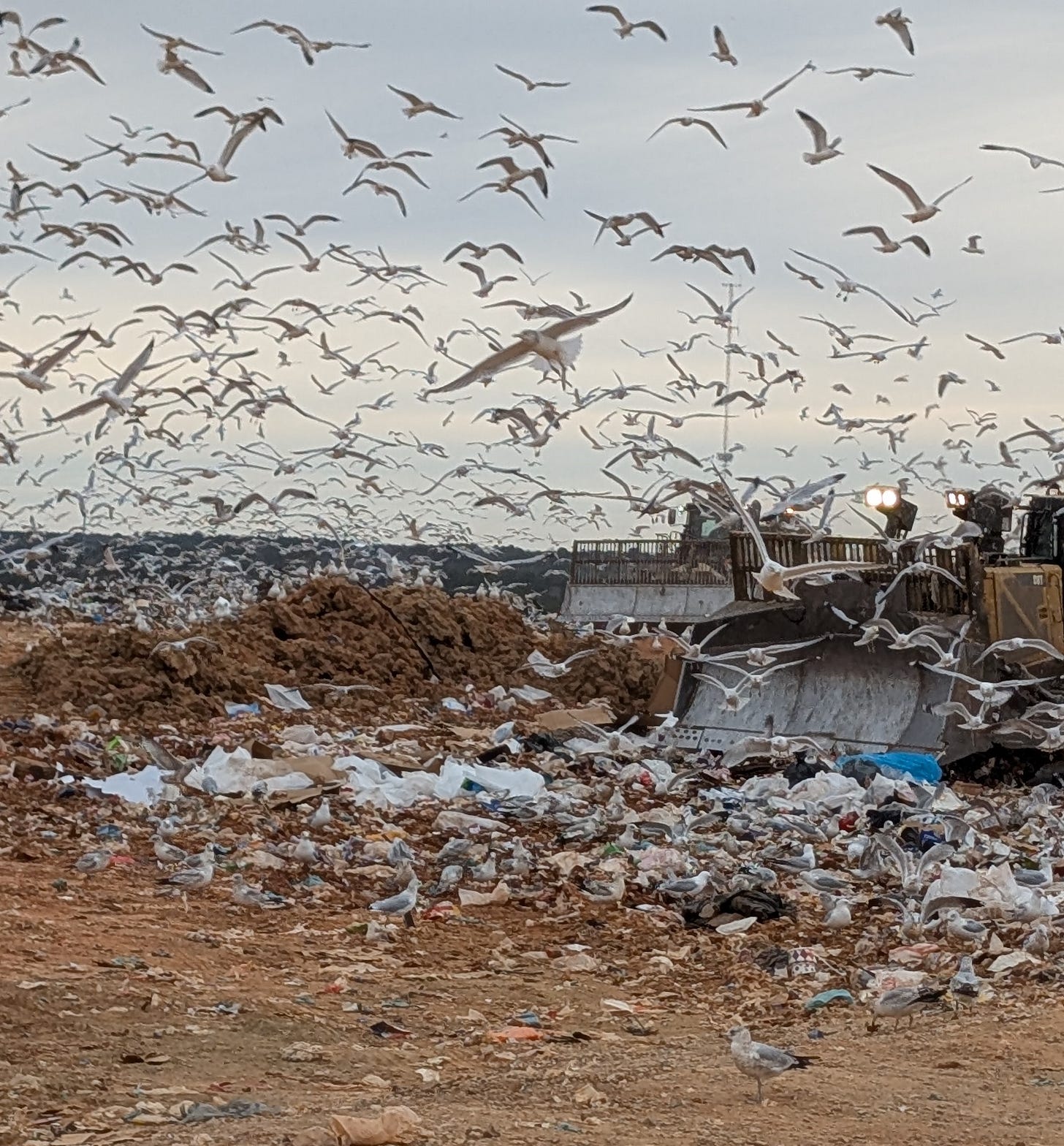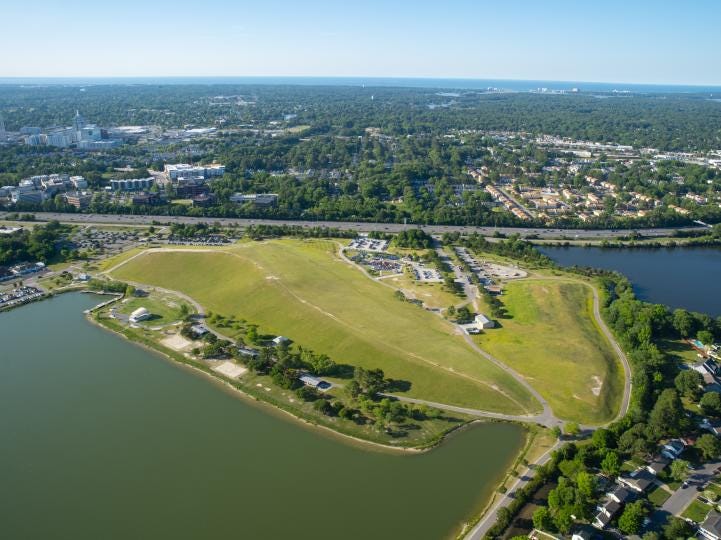PART 4: Dumping on Holly Springs: The South Wake Landfill - Past, Present, and Future
FINAL: Part 4 of this 4 part series explores the future of South Wake Landfill and waste management in Wake County.
Introduction: A four-part series
Holly Springs has been home to Wake County’s largest landfill for decades, shaping the town’s history, environment, and community concerns. This four-part series explores the South Wake Landfill’s past, present operations, environmental consequences, and future. Part 1 covers the history of waste disposal in Holly Springs, while Part 2 examines landfill operations and challenges. Part 3 explores environmental and health impacts, and Part 4 looks ahead to its closure and future land use. As Holly Springs grows, the landfill remains a pressing issue, raising questions about long-term sustainability and Wake County’s waste management strategy.
Post-Closure Land Use Options
Wake County is actively exploring a range of potential uses for the South Wake Landfill site after it reaches capacity and undergoes formal closure procedures. These post-closure land use plans aim to ensure long-term environmental safety while transforming the site into a valuable community resource aligned with the county’s sustainability goals.
Renewable Energy Development
One of the most prominent proposals is repurposing the site as a renewable energy hub. Wake County already operates a landfill gas-to-energy system at South Wake, converting methane into electricity for approximately 4,000 homes. After closure, this system would continue functioning, capturing residual methane for decades.
Building on this, officials are evaluating the feasibility of installing solar panels over the capped landfill. Because closed landfills cannot support heavy structures, solar farms are ideal due to their minimal ground disturbance. Similar projects have succeeded elsewhere:
Cincinnati, OH, repurposed a landfill for a 5-megawatt solar farm powering 400 homes.
South Burlington, V,T installed over 7,000 solar panels on a closed landfill to power municipal operations.
South Wake could follow suit, combining methane and solar energy production into a single, sustainable post-closure use.
Recreational and Green Space
Another option is developing the site into a public green space. The landfill will reach an elevation of roughly 520 feet above sea level—making it the highest point in southern Wake County—and could serve as a scenic and recreational destination for residents and visitors. At closure, the site will tower above the average Holly Springs location by more than 140 feet.
Potential features include:
Walking and biking trails around and over the closed landfill
Scenic overlooks with panoramic views
Disc golf or other low-impact recreational amenities
Notable examples include:
Mount Trashmore Park in Virginia Beach, VA, transformed a landfill into a city park with trails, lakes, and playgrounds.
Freshkills Park in Staten Island, NY, is now being developed into a 2,200-acre park on the former site of the world’s largest landfill.
Educational and Environmental Use
The site could also support environmental education and outreach. Partnering with local schools and universities, Wake County could develop:
A visitor center explaining landfill engineering, waste-to-energy technology, and environmental monitoring
Field trip programs focused on sustainability and solid waste
Citizen science initiatives for ongoing ecological monitoring
Such initiatives would provide transparency while turning the landfill’s legacy into a learning opportunity for the region.
Planning Considerations
The North Carolina Department of Environmental Quality (NCDEQ) must review and approve all post-closure development plans. Several key factors will determine what is feasible and safe on the closed site:
Soil Stability and Ground Settlement: As waste decomposes, the landfill surface will continue to settle for decades. This limits structural development and necessitates flexible, lightweight installations. For example, improper settlement planning near the BKK Landfill in West Covina, CA, led to costly infrastructure damage. Any trails, solar installations, or public facilities at South Wake must be designed with these shifting conditions in mind.
Gas Venting and Methane Control: Methane and other landfill gases can continue to be generated for years after closure. These gases must be safely vented to avoid fire, explosion, or indoor air hazards. In Stearns County, MN, methane from a closed landfill migrated into nearby buildings due to poor venting, leading to evacuations and retrofitting. Wake County must maintain and monitor its gas collection system and ensure that post-closure designs avoid enclosed or poorly ventilated areas.
Public Safety and Access: Any future recreational or educational use must consider public safety. Closed landfills can present hazards like sinkholes, exposed piping, or gas venting infrastructure. Parks like Mount Trashmore succeed because of upfront investment in fencing, signage, and regular inspections. Similar safety measures will be essential at South Wake.
Environmental Monitoring and Long-Term Stewardship: Regulations require at least 30 years of post-closure monitoring for groundwater, leachate, and air quality—potentially more, depending on site conditions. Freshkills Park in New York continues intensive environmental oversight decades after its closure. Wake County must commit to operational oversight and financial planning to ensure South Wake remains safe and well-managed.
The Future of Waste Management in Wake County
Wake County is approaching a critical crossroads as the South Wake Landfill continues toward its projected closure around 2040. The landfill—expected to hold more than 12 million tons of waste by the time it reaches capacity—has served as the county’s primary disposal site for nearly two decades. With no replacement facility currently planned, officials must decide how to manage the county’s growing waste stream in the years ahead. The future of waste management in Wake County will likely involve a combination of strategies, each with its benefits and challenges, as demonstrated by counties across the country that have faced similar transitions.
One likely path is exporting waste to other landfills, a strategy already used in many major cities. After the closure of Fresh Kills Landfill in 2001, New York City began shipping its waste by rail and truck to Pennsylvania, Ohio, and Virginia facilities. This approach eliminates the need to build a new landfill locally—often a politically fraught and expensive endeavor—but it comes with trade-offs. Hauling waste long distances increases fuel use, greenhouse gas emissions, and long-term costs while also making the county dependent on external contractors and landfill availability in other regions.
Another option is developing a waste-to-energy (WTE) facility, which incinerates trash and converts the heat into electricity. These facilities can reduce the volume of waste by up to 90%, easing pressure on landfill capacity and creating a renewable energy source in the process. In Fairfax County, Virginia, a WTE facility processes nearly a million tons of waste annually while powering tens of thousands of homes. However, the high cost of building and maintaining such facilities—and ongoing concerns about air quality and emissions—make this a challenging option politically and financially. WTE plants also require a consistent waste stream to remain economically viable, which could conflict with efforts to increase recycling and composting.
A more sustainable, long-term approach may involve maximizing waste diversion through recycling, composting, and materials recovery. Cities like San Francisco and Austin have made significant progress toward zero-waste goals by implementing mandatory composting, expanding curbside recycling, and incentivizing businesses to reduce waste. Wake County has already invested in recycling infrastructure, and further developing these services could dramatically reduce the volume of material requiring disposal. However, building an effective diversion system would require robust public education, new processing facilities, and strong market demand for recovered materials—none of which are guaranteed.
The county could also explore developing a new landfill, independently or in partnership with surrounding jurisdictions. This would restore local control over waste management and reduce the need for long-distance hauling, but finding a suitable site could prove difficult. As seen in communities across the country, the "Not In My Backyard" (NIMBY) reaction often halts landfill siting before it begins. The permitting process is long, expensive, and subject to intense public scrutiny, particularly in rapidly growing counties like Wake, where land is in high demand.
Whatever direction Wake County takes, the decisions made now will shape the region’s environmental and public health outcomes for decades. As the South Wake Landfill nears closure, Wake County faces a logistical challenge and a broader opportunity: to redefine how a fast-growing community deals with its waste in a sustainable, resilient, and responsive way to the people it serves.
Published:
Part 1: A History of Landfills in Holly Springs and the South Wake Landfill
Part 2: The South Wake Landfill Today – Operations, Management, and Challenges
Part 3: The Environmental and Health Impact of the Landfill
Part 4: The Future of Waste Management in Wake County




Loved Mt Trashmore when we lived in Va Beach!